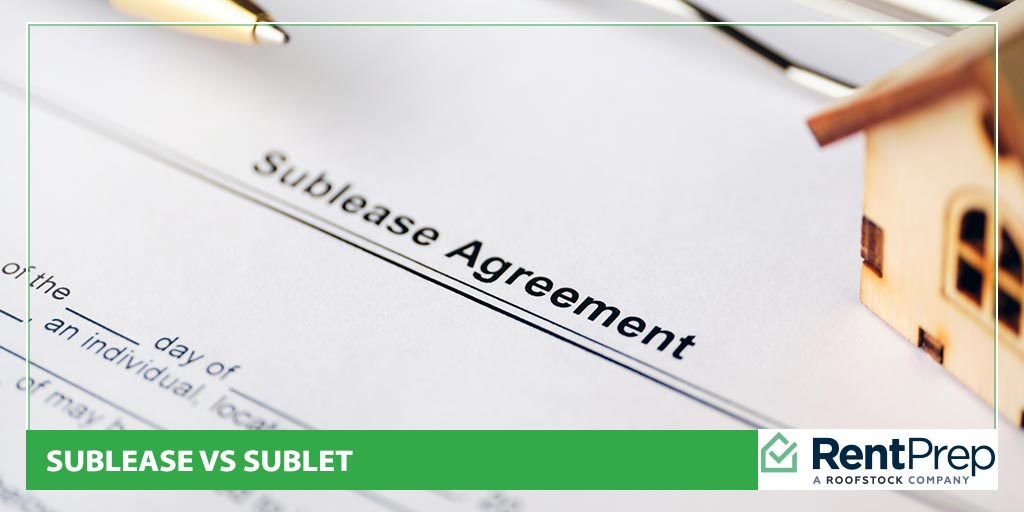
Are you curious about the differences between a sublease and a sublet? Although often used interchangeably, these terms actually refer to two different arrangements for tenants.
In a sublease, the original tenant and the subtenant make the deal, while a sublet involves the landlord and the subtenant directly. In both cases, however, the landlord’s approval is required.
In this article, we’ll break down the distinctions between subleasing and subletting, including variations like short-term subleasing, such as vacation rentals.
We’ll also weigh the pros and cons of letting tenants sublease and offer tips for managing both subleasing and subletting in your lease agreements.
Plus, we’ll give you some helpful advice you can pass on to your tenants if you allow subleasing.
Table Of Contents: Subleasing vs. Subletting
What are the specific differences between a sublease and a sublet that landlords need to know about?
- Sublease vs. Sublet: What’s The Difference?
- Pros And Cons Of Allowing Subleasing For Landlords
- Managing Subleasing And Subletting In The Lease
- Subleasing Agreement
- FAQs About Subleasing
- Do tenants need a landlord’s permission to sublet?
- What should be included in a sublease agreement?
- Can tenants charge more rent to their subtenant than the original rent?
- What happens if the subtenant doesn’t pay rent?
- Who is responsible for damages caused by the subtenant?
- Is the landlord responsible for the subtenant?
- Get Smart About Subleasing
Sublease vs. Sublet: What’s The Difference?
While the terms are often used interchangeably in casual conversation, subleasing and subletting refer to different legal arrangements regarding property occupancy. Let’s examine each.
Sublease

A sublease occurs when the original tenant, also known as the primary tenant, who has signed a lease with the landlord, creates a lease agreement with a subtenant, allowing the latter to use all or part of a property during their own lease period.
The original “master lease” between the landlord and the original tenant remains in effect. The original tenant continues to be responsible for fulfilling the obligations of the lease, including paying rent and maintaining the property, even if the subtenant breaks their sublease conditions.
While there is typically no direct relationship between the landlord and the subtenant in a sublease situation, the landlord must give permission to open a sublease on the property in the original lease. Otherwise, the primary tenant, who is still responsible for the original lease, could be in breach of their rental agreement. Finding that a tenant is subleasing without permission can be grounds for a landlord to terminate a lease agreement and seek eviction.
Read our FAQs on tenants subleasing without permission.
Tenants often sublease their spaces when they need to move before the end of their lease, or they may sublease part of the rental property to help cover expenses.
A tenant may also decide to travel for a number of months but plan to return and, therefore, sublease for a while until they’re ready to reoccupy the property.
If a tenant chooses to make money from their rental home using short-term vacation rental services, this is also considered subleasing.
While some landlords are happy to allow this kind of activity, others are not. Landlords will often deal with short-term subleasing separately and specifically in the lease since it tends to cause more disruption to neighboring tenants and can increase the risk of damage to the property.
Sublet
A sublet will often happen under similar circumstances, for example, when a tenant needs to move for work and can no longer complete the full term of their lease. However, in this case, rather than the tenant finding a subtenant for their place, the landlord finds a new tenant and offers them the remainder of the lease.
Typically, the original tenant must continue paying the rent until the sublet can be finalized. However, the landlord is obligated to find a subtenant as quickly as possible.
For example, as of July 2019, landlords in New York are responsible for mitigating damages by trying to re-rent their property reasonably quickly. Once the new tenant begins paying rent, the original tenant’s responsibility for rent for the balance of the original term ends.
The Pros And Cons Of Subleasing: A Landlord’s Perspective
There are many reasons why you might consider giving your tenant a relative amount of freedom when it comes to subleasing.
- Subleasing ensures that the rent continues to be paid, even if your original tenant must leave temporarily or permanently, with minimal administrative overhead for the landlord since the tenant must manage the situation.
- The flexibility that subleasing provides can attract desirable tenants who may anticipate needing the option if, for example, they are frequent travelers.
However, there are risks involved with subleasing, which is why many landlords choose not to allow the practice.
- You lose control over tenant screening and deciding whether a tenant is a suitable fit for your property. Although you can require the approval of any tenant, you are still displaced in the selection process.
- The more a rental property changes hands, the more wear and tear will likely occur. Remember, you can’t charge tenants for standard wear and tear, only property damage.
- While subleasing is designed to ensure your income flow, if your tenant has problems with your subtenant, you can be affected as well.
- Legal action against a subtenant can be more challenging if they create issues at the property, as their legal contract is with your original tenant and not you. You may need their cooperation to take legal action if necessary.
- Subleasing, especially short-term subleasing, can impact the community and lead to conflicts and complaints from neighbors.
As a landlord, it’s up to you to balance the pros and cons of your particular circumstances and decide whether you want to allow your tenants to sublease.
Managing Subleasing And Subletting In The Lease

Landlords should include clauses to manage both subleasing and subletting in their original lease agreements to maintain control of their properties. Unfortunately, many standard rental contracts still do not contain clauses about subleasing.
Subleasing Clauses
As a landlord, you decide whether or not to allow your tenant to sublease your property. This can be beneficial, as you won’t have to spend time and money finding a subtenant if the original tenant needs to leave.
However, it also represents a risk, as the landlord does not have the opportunity to screen the subtenant and ensure they do not have a history of eviction, for example.
Allowing subleasing or not can be on a spectrum. The lease agreement can deny subleasing in all circumstances. On the other end of the spectrum, it can give the original tenant full rights to sublease part or all of the property as long as they continue to meet the conditions of the lease agreement, which means paying rent and maintaining the property. The lease could also allow the tenant to apply to the landlord for separate written permission to sublease without providing a reason. The landlord could also charge a reasonable fee.
The question of subleasing for short-term stays can be dealt with separately in the contract. Short-term vacation rentals may still be prohibited in your area if you do not include a subleasing clause in your lease.
The lease may also contain restrictions on the number of people who can occupy the property and provisions restricting the tenant from using the property for a home business.
Subletting Clauses
The section of the lease dealing with early contract termination should cover subletting also. This clause typically reinforces that the tenant is responsible for paying rent until the end of their original contract but that the landlord will attempt to find a sublet tenant as quickly as reasonably possible to take up the obligation.
This is not the only way to terminate a lease early. Some landlords prefer tenants to pay a one-time fee to streamline the process. Find out more about lease termination clauses here.
Subleasing Agreement
If you decide to allow your tenants to sublease their space, it can be a good idea to advise them to put in place a subleasing agreement similar to the agreement between you and the tenant.
Just like a lease, a subleasing agreement should contain:
- The names and details of the original tenant and the subtenant
- The dates of the agreement
- Details of the premises
- Details of the rent and when and how it should be paid, including consequences for late payment
- Conditions for early termination
- How utilities will be managed
- Security deposit details, what the deposit can be used for, and how it will be refunded
- Appropriate use of the property and subtenant maintenance responsibilities
- Reference to the master lease upon which the conditions of the sublease depend
From the landlord’s perspective, it’s important that the sublease agreement acknowledges that the terms of the sublease are subject to the terms and conditions of the lease agreement between the original tenant and the landlord. A copy of that lease should be made available to the subtenant. The subtenant should be asked to agree to comply with the details of the master lease agreement where applicable.
Sublease vs. Sublet FAQs
Below are answers to some of the most frequently asked questions from landlords about subletting and subleasing.
Do tenants need a landlord’s permission to sublet?
Yes, in most cases, a tenant needs their landlord’s permission to sublet their rental unit. Many lease agreements explicitly require the tenant to obtain the landlord’s consent before subletting. Failing to get permission could lead to violations of the lease terms, based on which the landlord might take legal action or evict.
What should be included in a sublease agreement?
A sublease should clearly outline the terms of the sublet, including the duration, the amount of rent and how the subtenant should pay, security deposit arrangements, and any specific rules or conditions of the sublet. It’s also wise to include the original lease terms to ensure the subtenant knows of any obligations or restrictions.
Can tenants charge more rent to their subtenant than the original rent?
Whether a tenant can charge more rent to their subtenant than they’re paying depends on local laws and the original lease agreement. While some landlords and jurisdictions may allow this practice, others might restrict it.
What happens if the subtenant doesn’t pay rent?
If the subtenant fails to pay rent, the original tenant remains responsible for paying rent in full to the landlord, as the original tenant’s name is on the original lease. The original tenant may need to cover any missing payments to avoid violating their lease terms. They can seek to recover the rent from the subtenant through small claims court or other legal means.
Who is responsible for damages caused by the subtenant?
Typically, the original tenant is responsible for any damages to the rental unit caused by the subtenant. The original tenant would need to pay to repair the damages or compensate the landlord accordingly. However, the original tenant can seek reimbursement from the subtenant, especially if such terms were included in the sublease agreement.
Is the landlord responsible for the subtenant?
The landlord’s primary legal relationship is with the original tenant, not the subtenant. While the landlord may have indirect responsibilities, such as ensuring the property meets habitability standards, the original tenant acts as the subtenant’s landlord under the sublease arrangement.
Be Smart About Subleasing
Life is unpredictable, so subletting and subleasing are standard parts of the rental business when tenants cannot complete their lease terms. As a landlord, the best thing you can do is ensure you are in total control of the subleasing situation by including detailed clauses in your rental agreement that let the tenant know what they can and cannot do.
It is possible to give tenants the freedom to sublease while protecting your overall interest. The key is not to leave things to chance but instead cover your bases in your lease agreement.
Note: RentPrep does not provide tax, legal or accounting advice. This material has been prepared for informational purposes only and is not intended to provide, and should not be relied on for, tax, legal, or accounting advice. You should consult your own tax, legal, or accounting advisors.

